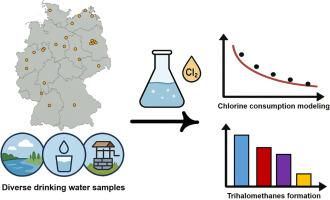Investigating chlorine consumption through semi-mechanistic modeling and its implications for trihalomethane formation: A comparison of diverse drinking water
IF 12.4
1区 环境科学与生态学
Q1 ENGINEERING, ENVIRONMENTAL
引用次数: 0
Abstract
In many regions, drinking water disinfection is crucial for the inactivation of microorganisms. However, chemical reactions between chlorine and natural organic matter and inorganic compounds can result in unwanted formation of disinfection by-products (DBPs). 25 non-chlorinated tap water samples from different regions of Germany were chlorinated to evaluate the chlorine consumption and formation of DBPs. Most of the water samples quickly consumed the initially dosed chlorine (NaOCl as 1 mg/L Cl2), leaving less than 10% residual chlorine after 2 h. A strong correlation between ultra-violet absorption at a wavelength of 254 nm (UV254) and chlorine consumption was observed. A mathematical model using this correlation could well predict chlorine consumption over time. The model can be used to design chlorine booster stations in water distribution networks. The formation of trihalomethanes (THM) including trichloromethane (chloroform), tribromomethane (bromoform), bromodichloromethane, and dibromochloromethane was analyzed. The results revealed varying levels of THM. While the highest total THM concentrations reached 93.8 μg/L, the lowest concentration was 10.7 μg/L.

通过半机械模型研究氯消耗及其对三卤甲烷形成的影响:不同饮用水的比较
在许多地区,饮用水消毒对微生物的灭活至关重要。然而,氯与天然有机物质和无机化合物之间的化学反应可能导致不必要的消毒副产物(DBPs)的形成。对来自德国不同地区的25个未氯化的自来水样品进行了氯化处理,以评估氯的消耗和dbp的形成。大多数水样迅速消耗了初始剂量的氯(NaOCl为1 mg/L Cl2), 2小时后剩余氯不到10%。254 nm波长处的紫外线吸收(UV254)与氯消耗之间存在很强的相关性。利用这种相关性的数学模型可以很好地预测氯的消耗量。该模型可用于配水网中氯升压站的设计。分析了三氯甲烷(氯仿)、三溴甲烷(溴仿)、溴二氯甲烷和二溴氯甲烷等三卤甲烷(THM)的生成。结果显示THM水平不同。总THM浓度最高可达93.8 μg/L,最低为10.7 μg/L。
本文章由计算机程序翻译,如有差异,请以英文原文为准。
求助全文
约1分钟内获得全文
求助全文
来源期刊

Water Research
环境科学-工程:环境
CiteScore
20.80
自引率
9.40%
发文量
1307
审稿时长
38 days
期刊介绍:
Water Research, along with its open access companion journal Water Research X, serves as a platform for publishing original research papers covering various aspects of the science and technology related to the anthropogenic water cycle, water quality, and its management worldwide. The audience targeted by the journal comprises biologists, chemical engineers, chemists, civil engineers, environmental engineers, limnologists, and microbiologists. The scope of the journal include:
•Treatment processes for water and wastewaters (municipal, agricultural, industrial, and on-site treatment), including resource recovery and residuals management;
•Urban hydrology including sewer systems, stormwater management, and green infrastructure;
•Drinking water treatment and distribution;
•Potable and non-potable water reuse;
•Sanitation, public health, and risk assessment;
•Anaerobic digestion, solid and hazardous waste management, including source characterization and the effects and control of leachates and gaseous emissions;
•Contaminants (chemical, microbial, anthropogenic particles such as nanoparticles or microplastics) and related water quality sensing, monitoring, fate, and assessment;
•Anthropogenic impacts on inland, tidal, coastal and urban waters, focusing on surface and ground waters, and point and non-point sources of pollution;
•Environmental restoration, linked to surface water, groundwater and groundwater remediation;
•Analysis of the interfaces between sediments and water, and between water and atmosphere, focusing specifically on anthropogenic impacts;
•Mathematical modelling, systems analysis, machine learning, and beneficial use of big data related to the anthropogenic water cycle;
•Socio-economic, policy, and regulations studies.
 求助内容:
求助内容: 应助结果提醒方式:
应助结果提醒方式:


